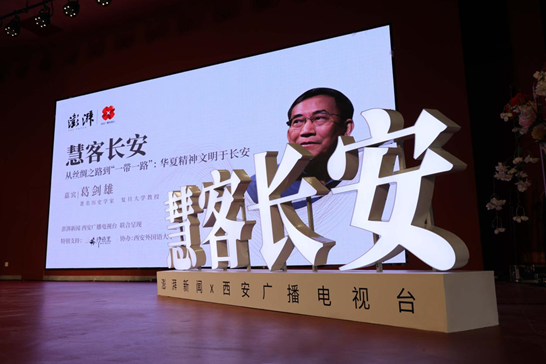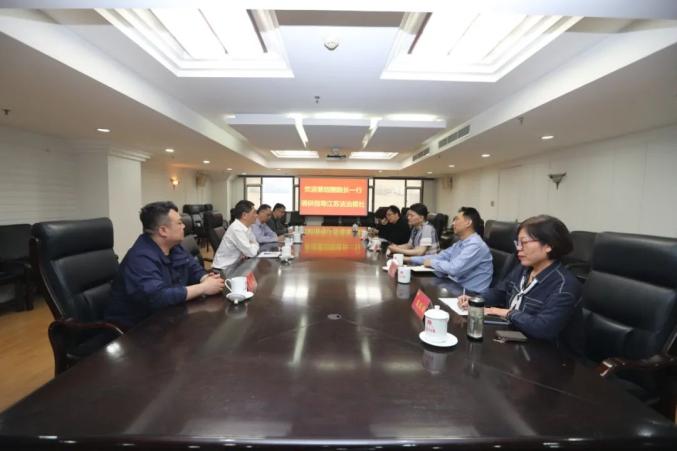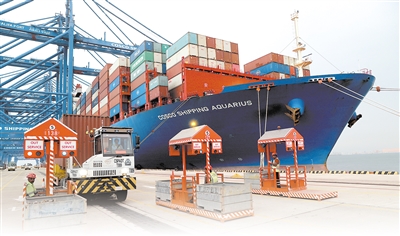21 Interviews丨Malaysian Minister Of Transport Luke: China And Malaysia Jointly Build The "Belt And Road" To Focus On Long-term Cooperation
21 Interviews丨Malaysian Minister Of Transport Luke: China And Malaysia Jointly Build The "Belt And Road" To Focus On Long-term Cooperation
"Malaysia's experience shows that first we must ensure that large-scale cooperative projects must have a long-term impact on both countries. In order to promote the success of the project, we cannot only focus on short-term cooperation, but must be long-term cooperation." Malaysia's Transport Minister Luke Sao Fu said.
"Malaysia's experience shows that first we must ensure that large-scale cooperative projects must have a long-term impact on both countries. In order to promote the success of the project, we cannot only focus on short-term cooperation, but must be long-term cooperation." Malaysia's Transport Minister Luke Sao Fu said.
On September 10, Malaysian Transport Minister Luke Lok accepted an exclusive interview with a reporter from 21st Century Business Herald when attending the 10th Belt and Road Forum in Hong Kong. He said that focusing on longer-term cooperation is an experience that China-Malaysia joint initiative can share with the outside world.
Malaysia is one of the first countries to support and actively participate in the joint construction of the "Belt and Road" initiative, and is also a model of success. After more than 10 years of development, Malaysia has developed steadily in various fields such as infrastructure, employment, science and technology, and economic and trade, and the people have benefited effectively. Among them, the Malaysian Malaysia-China-Kuntan Industrial Park, which opened 12 years ago, has developed in a coordinated manner with the China-Malaysia Qinzhou Industrial Park, creating an international industrial cooperation model of "two countries and two parks", injecting strong impetus into the high-quality joint construction of the "Belt and Road" between China and Malaysia.
Lu Zhaofu said, "With China and Malaysia's 'two countries and two parks' model, the two sides will be deeply integrated at the policy and regulatory levels. Therefore, in this regard, it greatly enhances mutual understanding."
He believes that Chinese companies are currently interested in advanced manufacturing, semiconductors, electronics and electrical fields, and Malaysia is considering how to ensure investment in rare earth investment, rare earth by-product manufacturing, and automobile or aerospace industries.
"For Chinese companies, they can use Malaysia as a springboard to enter the global market," he said.

Luke Choi-fu. Data map
East Coast Railway will achieve more industrial development
"21st Century": Malaysia East Coast Railway (ECRL) is a flagship project for China and Malaysia to jointly build the "Belt and Road" with high-quality cooperation. It is about 665 kilometers long and spans four states in Malaysia. How do you view the impact of this project on Malaysia's economy, people's livelihood and other aspects?
Lu Zhaofu: Malaysia's East Coast Railway is currently one of the largest infrastructure projects under construction in the country and the largest infrastructure project led by the Malaysian government. The railway is 665 kilometers long and spans many states on the Malay Peninsula, closely connecting the east coast of the Malay Peninsula with the west coast. The first phase of this key project is expected to be completed in 18 months. Phase II will be launched, which will eventually extend the railway to Port Klang, the main portal of Malaysia. We are discussing with China the possibility of extending the East Coast Railway to the Thai border in the northern Malay Peninsula.
In terms of impact, once the project is completed, it will have a significant impact on Malaysia. We hope that the corridors along the route can achieve more industrial development.
"21st Century": What cooperation projects do China and Malaysia have left a deep impression on you?
Lu Zhaofu: In terms of transportation projects, we have carried out extensive cooperation with China. Chinese-funded enterprises have been involved in construction in Malaysia for more than ten years. One of the most important bridges in Malaysia, Penang Second Sea Cross-Sea Bridge, was constructed by China Harbor Engineering Co., Ltd. and is also a landmark project.
Currently we have multiple projects under construction with China. As I mentioned before, in addition to the East Coast Railway, we have also purchased most of the railway vehicles from China CRRC, which has a manufacturing base in Malaysia. In addition, our private enterprises have also cooperated with Chinese private enterprises, such as Proton Auto and Geely Auto for joint production, which are important transportation projects that we jointly promote with China.
"21st Century": In terms of infrastructure construction, what areas can the two sides focus on cooperation in the future?
Lu Zhaofu: At present, we attach great importance to the construction of railway networks, aiming to accelerate the development of railway networks. We implement the "road to rail" policy, aiming to shift cargo transportation from roads to railways. At present, cargo in and out of ports and industrial parks still rely heavily on truck transportation. First of all, we hope to reduce the number of trucks on the road through railway transportation, thereby reducing the traffic accident rate. Secondly, from the perspective of sustainability and environmental protection, railway transportation is more favorable. Therefore, we hope that the development of railway networks will continue to attract attention. The completion of the Malaysian East Coast Railway will improve the existing railway network, and we will continue to pay attention to this aspect.
Jointly building the "Belt and Road" focuses on long-term cooperation
"21st Century": Malaysia is one of the first countries to support the joint construction of the "Belt and Road" initiative. What highlights are worth sharing with other countries in the cooperation between China and Malaysia under the framework of high-quality joint construction of the "Belt and Road"? How will China and Malaysia cooperate in the framework of high-quality joint construction of the "Belt and Road" in the future, and in which areas will have more cooperation potential?
Luke: Malaysia's experience shows that first we must ensure large-scale cooperative projects, which must have a long-term impact on both countries. In order to make the project successful, we cannot only focus on short-term cooperation, but must be long-term cooperation. Taking Malaysia East Coast Railway as an example, what we negotiated with China is not only about engineering construction, but also about joint operations after completion. China will work with us to carry out passenger and freight business, and through this in-depth cooperation, we have ensured the sustainability of the project. If the project cannot continue to operate and there is no train or cargo transportation after completion, the project will fail.
What we are seeking is long-term cooperation and the two parties operate together. Through this joint operation, both parties must also consider how to ensure more cargo is transported along the railway corridor. So, in addition to railway companies, we are also considering how to attract more companies to set up factories along the railway corridor so that more goods can be transported by the East Coast rail.
In this regard, we are concerned with long-term trust and long-term cooperation, and we must consider issues from a longer-term perspective.
The cooperation model can radiate to more regions
"21st Century": How does the "Two Countries and Two Parks" project in China and Malaysia help China deepen industrial cooperation?
Lu Zhaofu: I think the "two countries, two parks" model is of great significance. First, it can attract large-scale investment from China and put the factory in Malaysia. As far as I know, the Malaysian Kuantan Industrial Park located in Kuantan has attracted investment from one of the largest steel mills in the region, United Steel (Malaysia) Group. Practice over the past few years has proven that the project has achieved great success and has also provided opportunities for Malaysian companies and manufacturers to build factories in China. Therefore, I think this cooperation will give both parties a better understanding of each other's systems. With the "two countries and two parks" model, the two sides will deeply integrate at the policy and regulatory levels, which greatly enhances mutual understanding.
"21st Century": With the continuous release of policy dividends such as the joint construction of the "Belt and Road" initiative, the China-ASEAN Free Trade Zone, and the Regional Comprehensive Economic Partnership Agreement (RCEP), ASEAN has become an important destination for many Chinese companies to "go global". What impact will these policies have on Chinese companies’ “going global”? Under the current tariff situation, what stage does Chinese enterprises "go global" develop to? How attractive is the Malaysian market to Chinese companies?
Luke: First of all, taking Malaysia as an example, Malaysia has ushered in investment cooperation in multiple fields. More and more Chinese companies are setting up operations in the region, which will help Chinese companies become global players. Southeast Asia is an important springboard for the global layout of Chinese enterprises. Through ASEAN or Malaysia, they can radiate to the global market, which will help strengthen the confidence of Chinese companies and help them grow into global companies. At the same time, we hope that this kind of cooperation can also bring welfare to the Malaysian people.
Getting more investment in Malaysia means more jobs will be created and more jobs will be provided to Malaysians, so we should seek to work closer together.
Currently, Chinese companies are quite interested in advanced manufacturing, semiconductors, electronics and electrical fields. We are considering how to ensure investment in rare earth investment, rare earth by-product manufacturing, and the automotive or aerospace industry. In general, Malaysia has many industries that are very attractive to Chinese companies. The benefits of Chinese companies investing in and building factories in Malaysia are that first of all, we have a very sound legal system, and secondly, we have good infrastructure. Chinese companies can use Malaysia as a springboard for entering the global market.
US tariff policy will not affect China-Malaysia cooperation
"21st Century": The United States' "reciprocal tariffs" imposed on Malaysia have been reduced to 19%. How does this tariff rate affect the development of Malaysia's industry? The semiconductor industry is exempted from US tariff policies. How do you view the development of Malaysia's semiconductor industry?
Lu Zhaofu: We maintain confidence in the continued growth of the semiconductor industry, because Malaysia has formed a strong industrial ecosystem, and many American-funded companies have invested in Malaysia's semiconductor industry.
At present, the United States has not imposed any tariffs on Malaysia's semiconductor industry. We will continue to act prudently to protect the semiconductor industry through negotiations.
We insist on balancing diplomacy, becoming friendly partners of all countries, and insisting on opening up trade. The Malaysian government’s policies and positions are very clear. We are friendly to all parties and hope to conduct business dealings with various countries. Because our ultimate goal is to achieve national economic development and people's well-being.
We maintain close and strong relations with the Chinese government. Malaysian Prime Minister Anwar has visited China four times in the past three years. The latest visit took place during the Shanghai Cooperation Organization summit held in Tianjin, which helped to enhance the trust and confidence of the leadership of both sides.
"21st Century": As of June 2024, Chinese companies have invested more than 130 billion yuan in Malaysia's manufacturing industry, creating 88,000 jobs. What impact will the US tariff policy have on Chinese companies investing in Malaysia?
Luke: I don’t think the US tariff policy will have a negative impact on investment, and the investment of Chinese companies will continue to grow. Strategic cooperation has been carried out between Malaysia and the Chinese government, and the Chinese leadership has a very clear position. Malaysia is a friendly partner of China and the preferred investment destination. Malaysia and China maintain close and strong relations, which will continue to enhance the confidence of Chinese companies in investment in Malaysia.
"21st Century": At present, Malaysia strives to promote the extension of the upstream technology-intensive links of the Malaysian industrial chain in the "2030 New Industry Blueprint" () and the "Malaysia Digital Plan" () to emphasize the strategic autonomy of local enterprises in the formulation of industrial standards, data governance architecture and high-end manufacturing capabilities. How will this promote the in-depth development of Malaysia's industrial chain? How should China and Malaysia cooperate in the field of industrial chain and supply chain?
Lu Zhaofu: An important policy consideration and key requirement when we cooperate with the Chinese government and attract Chinese companies to invest in Malaysia is that we hope to achieve technology transfer and insist on localization of any project, not only create job opportunities for local people, but also drive the development of Malaysian small and medium-sized enterprises through localization of parts and supply chains. This is what we should continue to promote and implement at present.
I think China fully understands the intentions behind these policies. Because we want to improve the level of economic development, we do not want to become just a manufacturing base, we also want to have innovative capabilities and create greater economic value. I think the Chinese government also fully understands and supports this. Our ultimate goal is to improve our own development level and continuously improve productivity. In this regard, China and Malaysia maintain close cooperation.
Mutual visa-free policy drives China-Malaysia tourism
"21st Century": As of July 13, there were 499 one-way and 997 two-way Malaysian flights per week (excluding charter flights), an increase from 435 and 870 last year, with a total weekly seat capacity of about 197,100. How do you view the impact of Sino-Malaysia visa exemption on both sides’ tourism industry? How many airlines are there between China and Malaysia?
Lu Zhaofu: The visa-free policy of China-Malaysia mutual has had a very positive impact on the number of tourists. In 2024, nearly 4 million Chinese tourists came to Malaysia, and this number is expected to be very strong this year. We hope that we can get to a higher level during next year's "Malaysia Tourism Year" and the number of tourists is expected to continue to grow. The visa-free policy provides great convenience for personnel movement and exchange.
At the same time, more Malaysians have also traveled to China to deepen their understanding of China. There are many cities in China that many Malaysians have never set foot in before. Of course, many Malaysians were familiar with Beijing, Shanghai, Guangzhou, and Shenzhen in the past, but there are many other cities in western China and other regions worth exploring. The visa-free policy will stimulate Malaysians' interest in exploring a broader China, which will surely greatly promote the development of tourism in both countries.
Airlines play an important role in this regard, and this month we have seen two more Chinese airlines launch routes. Not only Malaysian National Airlines (Malaysia Airlines) and AirAsia flights to China, but also large airlines such as China Eastern Airlines and China Southern Airlines have not only opened routes to Kuala Lumpur, but also covered other parts of Malaysia. At present, many local Chinese airlines, such as Xiamen Airlines, and some small and low-cost airlines have also opened routes to Malaysia, which will surely bring more tourists to Malaysia.
"21st Century": You mentioned that Southeast Asia is becoming increasingly interested in the COMAC C919 passenger plane. What do you think of the cooperation potential of COMAC and Indonesian commercial aviation?
Lu Zhaofu: Malaysian airlines have a strong interest in purchasing and negotiating COMAC's products. I know at least one airline in Malaysia has shown strong intentions about purchasing C919. We look forward to this vision to be realized, as the emergence of more suppliers in the aviation manufacturing industry has positive implications for the global market. The current range of aircraft selection is very limited and we can only rely on a few manufacturers. If C919 can join the market in the future, it will not only help reduce aircraft procurement costs, but more importantly, it will speed up aircraft supply.
As far as the Malaysian government is concerned, we are open to purchasing C919. We welcome the cooperation between the two sides. The Civil Aviation Administration under the Ministry of Transport of Malaysia will provide full cooperation in standard certification and regulatory recognition. We aim to simplify and facilitate the approval process for COMAC to obtain operational licenses in Malaysia. Of course, the final purchasing decision lies with private enterprises, i.e. airlines. But at the government level, we are ready to provide full support and convenience.
Set an example of urban development model in the Greater Bay Area
"21st Century": What do you think about the development of the Guangdong-Hong Kong-Macao Greater Bay Area? How do you feel about the business environment in the Guangdong-Hong Kong-Macao Greater Bay Area?
Luke Lu: I have been to Hong Kong many times, but I can’t count the specific times. The development of the Guangdong-Hong Kong-Macao Greater Bay Area is indeed amazing. It is hard to imagine that cities such a neighboring city can each burst out with strong vitality and achieve economic integration in the Greater Bay Area. This is a good reference for other parts of the world.
It sets an example for the world in terms of urban development and urban planning. The interconnection of the Guangdong-Hong Kong-Macao Greater Bay Area always amazes me. Here bridges, highways and trains connect all the cities together. What’s even more amazing is that you can not only take the high-speed rail from Hong Kong to other cities in the Guangdong-Hong Kong-Macao Greater Bay Area, but also to other places in China. This is worth learning from and worth learning from many other countries to let them see how connectivity promotes progress and development.





